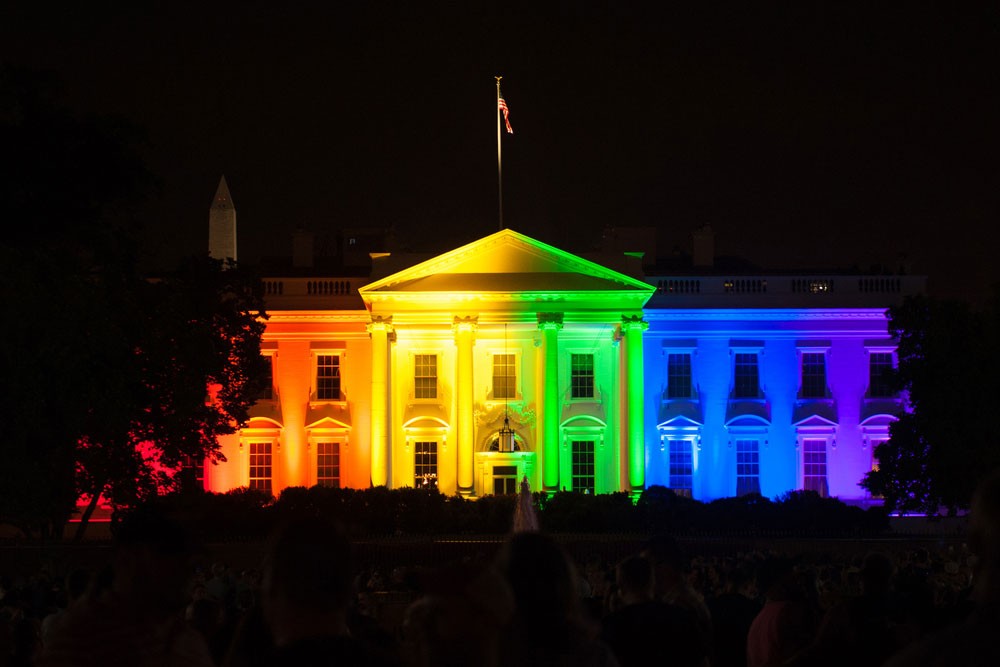We’ve come a long way, baby—but we still have a long way to go
No doubt about it, LGBT rights activists scored a huge win in June 2015: nationwide marriage equality. The Supreme Court of the United States confirmed that all loving couples have the constitutional right to marry. The ruling has built a solid legal foundation for LGBT-headed families across the country.
In addition to benefiting married LGBT parents, the Supreme Court decision will result in a stronger legal safety net for some LGBT solo parents. Now a widowed parent will receive social security benefits, avoid inheritance tax burdens, and be eligible for bereavement leave. Now LGBT parents who choose to divorce have clear guidelines for separating assets, establishing spousal support, and providing for their children.
Perhaps equally as important as the rights affirmed by the Court is the message this decision sends to the nation: LGBT people deserve “equal dignity in the eyes of the law.”
While iconic buildings, city streets, television screens, and the Internet lit up with celebratory rainbows on June 26, leaders of the LGBT civil-rights movement cautioned that marriage is but one important step in the march toward full equality.
Here are five essential rights that LGBT parents are still waiting for:
- Protection against employment discrimination. Across the country, 52% of LGBT people live in states where they can be fired based on their sexual orientation or gender expression. Although some states protect their public employees from workplace discrimination, only 20 states protect all LGBT people from discrimination in public and private workplaces. This lack of protection against employment discrimination is particularly detrimental to single-income solo parents and their children.
- Protection against housing discrimination. Due in part to soaring housing costs, the financial realities of single-income households, and societal assumptions about solo-parent families, finding safe and affordable housing can be a challenge for solo parents. LGBT parents face the added burden of state-sanctioned housing discrimination. Across the nation, 28 states offer no protections against housing discrimination based on sexual orientation; 31 states offer no protections based on gender identity.
- Protection against discrimination in public accommodations. Although laws cannot govern the opinions of individual citizens, the Civil Rights Act of 1964 did set legal standards for equality, prohibiting discrimination based on race, color, religion, or national origin in places of public accommodation, including private businesses such as restaurants, banks, hotels, and stores. In 1990, the Americans with Disabilities Act extended similar protections to people living with disabilities. However, LGBT people receive no federal protections against discrimination in public accommodations, and only 20 states offer comprehensive state-level protections, leaving LGBT parents and, by association, their children vulnerable to refusal of service in everyday locations such as grocery stores, ice cream shops, and movie theaters in 30 states across the nation.
- Safety in schools. Throughout the country, laws and regulations affecting LGBT students and children of LGBT parents vary. Although some states protect LGBT students and those associated with the LGBT community from bullying and discriminatory school policies, 24 states have no laws protecting LGBT students against bullying, and 32 states have no laws to protect LGBT students against discrimination. In fact, two states, South Dakota and Missouri, have enacted laws prohibiting schools from naming sexual orientation or gender identity in their school anti-bullying and anti-discrimination policies. Further, eight states have “Don’t Say Gay” laws on the books, restricting teachers and staff from talking about LGBT issues and people. National statistics paint a bleak picture of the LGBT student experience. According to the 2013 National School Climate Survey, 74.1% of LGBT students reported being verbally harassed at school, 55.5% reported experiencing discriminatory policies or practices, and 17.5% reported being prohibited from discussing or writing about LGBT topics for school assignments. Hostile school climates make a negative impact on the educational experiences of both LGBT students and children of LGBT parents.
- Custodial rights of LGBT parents. The Supreme Court marriage decision not only affirmed LGBT couples’ right to civil marriage but also opened up access to existing laws in many states that allow nonbiological parents in legal marriages to establish legal connections to their children. These undeniable legal bonds strengthen intact families, and they protect the custodial rights of LGBT parents facing divorce. Despite these newly available protections, some LGBT parents will continue to face legal challenges to their custodial rights. Transgender parents, parents who come out as gay while married to an opposite-sex spouse, and parents whose spouses have died sometimes find their custodial rights challenged by ex-spouses or surviving family members who, despite volumes of evidence to the contrary, question their fitness as parents based on their sexual orientation or gender identity. Where family law allows judges to consider sexual orientation or gender identity in child-custody disputes, LGBT parents and their children remain vulnerable to the whims of the court.
Indisputably, the LGBT community has seen extraordinary progress over the past 15 years, but when it comes to achieving “equal dignity under the law,” we still have a long way to go.
Image via Rena Schild/Shutterstock.com
Cheryl Dumesnil, ESME’s LGBTQ Resource Guide, is an author, educator, writing coach, all-around do-gooder, and one of two moms separately coparenting two amazing boys. You can follow her on Twitter at @cheryladumesnil.
Please feel free to contact us with any comments or questions.









